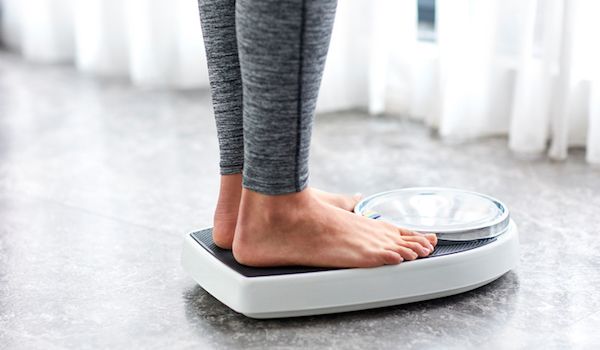Losing fat is different to losing weight. Nutritionist May Simpkin gives an 8 step guide on exactly how to lose body fat and keep it off
When I see clients for the first time, losing weight frequently tops their list of health goals.
But in many cases, it’s even more specific: to lose fat around certain areas. More often than not, they want to lose most of their weight from around the middle.
After all, improving your overall health and wellness, reducing health risks and changing the way your body looks and feels must be worth making an effort for?
Yet, despite the many articles offering advice, meal plans and even food delivery services to help you achieve these goals, there is still much confusion as to how exactly you can lose body fat – which is not the same as losing weight.
Where does the weight we lose actually go?
It seems such a simple question but the answer may be surprising. Many would suggest that fat is converted to energy and simply ‘burnt away’ or converted to muscle. However, the answer is in fact ‘into thin air’ and ‘down the loo’.
This is because, when fat is broken down, it is converted to carbon dioxide, which you then exhale, and water, which enters into your body system until it is eventually excreted as urine or sweat.
Unfortunately this doesn’t mean that you just need to exhale more to lose weight (imagine that!) – this will only leave you feeling dizzy and lightheaded.
However, regularly moving your muscles will increase the amount of carbon dioxide your body produces. In fact, simply standing or carrying out day to day chores can significantly increase your metabolic rate and therefore increase the amount of carbon dioxide exhaled.
More strenuous activities such as housework and walking will further enhance this effect.
What impact does food have on weight loss?
When it comes to food, you should avoid restricting your calories severely through crash diets or cutting out an entire food category.
This is because the weight loss you will experience from a severely restricted diet will not actually be fat loss, but rather loss of water at the outset.
Crash diets are notoriously hard to sustain and once you’re back to your original eating habits, the weight will quickly reappear on the scales as water is replaced.
However, if you opt for a less harsh approach to weight loss, with healthier, balanced choices along with moderate activity, you are more likely to sustain this way of eating.
Your body will still initially register weight loss that can be attributed to water loss but if you carry on, the weight you then lose after that will be fat.
Increasing your muscle mass, while losing fat, will boost your metabolism and help speed up weight loss
If you continue with a highly restricted eating pattern, you will also lose muscle. This is not ideal as this will cause your metabolism to drop as your body burns more calories.
It’s actually more beneficial to increase your muscle mass while losing fat, so that you also increase your metabolism, helping speed up weight loss.
If you don’t provide your body with enough calories and your body fat becomes too low, it will need to seek out alternative energy sources and start to break down muscle as a result.
As you age, metabolism tends to slow down. However, there is plenty you can do to help maintain good metabolism levels as well as build muscle to help promote your fat loss – without feeling tired. Here are my top steps to turning your body into a fat-burning lean machine.
1. Eat an early dinner
Studies show that eating dinner by mid-afternoon alters you body’s fat and carbohydrate burning patterns, which could help you lose fat.
There are various forms of time-restricted feeding including the popular 5:2 (fast for two days on 500 calories, eat healthy but normally for five) or 16:8 (finish eating by 8pm and start eating again at midday the next day leaving 16 hours between last night’s dinner and the next day’s breakfast) diets.
In fact, researchers have concluded that eating between 8 am and 2 pm, followed by an 18-hour daily fast kept kept appetite levels more even throughout the day, in comparison to eating between 8 am and 8 pm.
This fasting approach works on the notion of restricting your energy intake to certain times. By doing so, it could be, as research suggests, an effective way to lose body fat.
After a meal, the digestive system processes and absorbs the food you have just eaten, so that your body can use the nutrients consumed.
Once carbohydrates have been used, the body will need to use its fat stores as a source of energy – which will result in weight loss
This process takes around 4 to 5 hours. During this time, the body will prioritise using the carbohydrates consumed as its preferred energy source, rather than rely on fat stored in the body.
Following a meal, insulin levels will be high, which means that the body is less likely to use fat as fuel. However, once the carbohydrates have been used, the body will need to use its fat stores as a source of energy – which will result in weight loss.
The key here is to ensure that each meal is balanced, satiating and nutrient dense. If you’re looking to get started on intermittent fasting, here’s a comprehensive Beginner’s Guide, including a 10-day meal plan to show you exactly what types of meals to include to ensure success.
2. Boost your protein intake
Protein is a complex nutrient that can boost your metabolism as part of the digestive process.
Researchers from McMaster University found that those eating high protein diets lost more body fat. Whilst the study involved a tough program of exercise and a controlled diet over four weeks, a similar outcome can be achieved by eating a more balanced meal with good amounts of protein.
Protein rich foods include meat, fish, chicken, eggs and cheese. Nuts, beans, lentils and other pulses are also loaded with protein if you’re vegan or vegetarian. Try these high protein overnight oats for a perfect breakfast or snack choice.
3. Eat more spicy foods
Spicy foods, especially those that contain Capsaicin (a compound in chilli peppers), have been shown to increase metabolism and stimulate the body to burn fat. It basically means, adding chilli and other spices such as paprika and turmeric can help the body burn fat.
It is important to remember that this effect will only be achieved as part of a balanced diet.
Other fat burning foods to make sure you add to your diet include green tea – six cups a day have been shown to help increase metabolism but make sure its strong and has been steeped for at least ten minutes – as well as beetroot powder and black pepper.
For a fat burning cocktail, mix one scoop (7g) of Healthista Body Food (£18.95 from Healthista Shop) which contains matcha green tea, beetroot powder, black pepper, Yerba Mate and other thermogenic (fat-burning) and performance-enhancing ingredients, into your water bottle (you can add dilute it in 250-500ml of water and sip our take as a shot, but the high amount of green tea it contains makes it quite bitter if you don’t dilute it!) and consumer ideally in the morning or before and during exercise.
READ MORE: 8 best fat-burning foods
4. Avoid alcohol (sorry)
Unlike many foods, alcohol provides empty calories – in other words, no nutrients.
Furthermore, alcohol is high in calories and sugar (especially when combined with mixers), providing an immediate fuel for the body to use, rather than fat, but which can quickly turn into excess fat when it’s not burned off.
The ‘liquid calories’ alcohol contains is a sure way to sabotage your efforts to lose fat.
5. …and other liquid calories
Whether it’s fizzy drinks, high sugar coffees, fruit juices or smoothies, drinks high in sugar and calories will send you on a blood sugar rollercoaster.
As a result, you will crave even more sugar. The excess sugar consumed will eventually be converted to fat, which is counter-productive when you are trying to lose body fat.
Try sparkling mineral water with a squeeze of lime or fresh strawberries and instead of a mega-latte-mocha-tastic coffee, try an Americano with a splash of milk.
6. Prioritise sleep
Sleep is the time that your body rests and repairs; allowing your muscles to grow and recover.
A 2010 study by the University of Chicago found that when those on a diet got a full night’s sleep, more than half the weight they lost was fat.
When they cut back on sleep, not only did this reduce the amount of fat loss to only one quarter, but they also reported feeling hungrier.
Without adequate rest, your satiation and hunger hormones, leptin and ghrelin, will be out of kilter. This can encourage cravings, in particular for sweet foods.
7. Do more low intensity cardio
Aerobic exercise requires fat as a primary fuel, so incorporating more aerobic activity into your daily routine will help to lose body fat.
Low intensity activities such as walking, cycling and running at a steady pace and done for at least 30 minutes at a time, can encourage your body into its fat-burning zone, so it can access the fat stores for a more efficient fuel source.
Shorter high intensity bursts will instead use glycogen stores in muscle instead of fat stores – but this will increase your fitness so make sure you incorporate a little into your exercise line up.
8. Build weight training into your life
Speaking of having a varied exercise routine, building weight training – whether that is actually lifting or doing programmes of light weights, resistance bands or body weight training – will help your body burn fat.
The reason for that is lean muscle mass needs more calories to survive than fat does because lean muscle is so metabolically active.
In real terms, that means that a body high in lean muscle will burn more fat even at rest than someone with more fat on their bodies.
DO THIS NOW: Healthista’s 30 day dumbbell challenge will get you started weight training
This is the annoying reason that sporty, athletic friend of yours seems to lose weight or stay the same when she goes on holiday and stops exercising.
Lean muscle has turned her body into a fat burning machine so that even when she lets go a little on holidays and stops working out, she still can’t put on weight. That could be you.
MORE USEFUL POSTS BY MAY SIMPKIN

For more information on how to lose weight, nutrient-rich recipes, and ideas visit www.maysimpkin.com or Follow May on Instagram: @maysimpkinnutrition or Twitter @MaySimpkin or Facebook
WIN a 4-night spa detox worth £1750
Healthista is giving you the chance to win an incredible spa detox break worth £1750 with spa specialists The Body Retreat at their gorgeous Somerset venue.
To enter, just take our 5-minute Gut Health survey
Related Healthista Content
Why can’t I lose weight? Nutritionist reveals 9 key mistakes
7 ways to GIVE UP dieting and finally lose weight
How to stay healthy on holiday – the nutritionist’s guide
How intermittent fasting helped this writer lose 4kg in four weeks and ALL her IBS cramps
Like this article? Sign up to our newsletter to get more articles like this delivered straight to your inbox.

























































